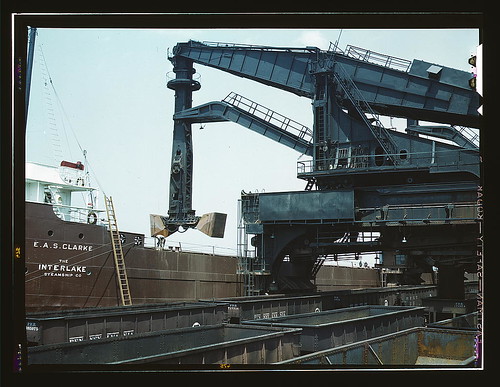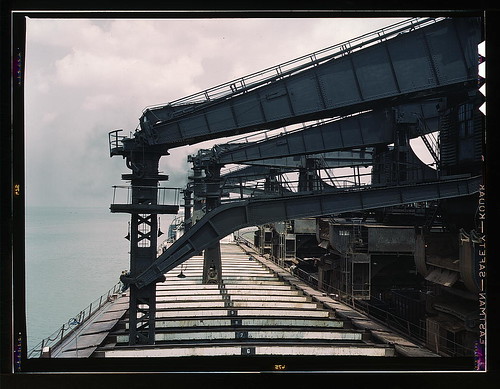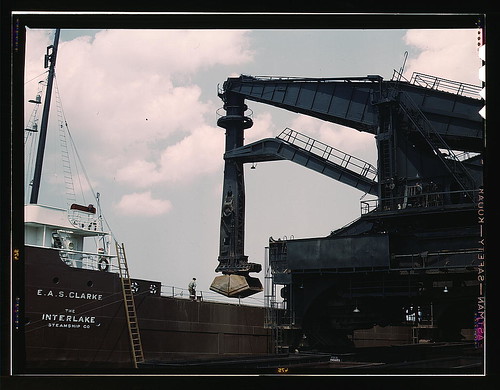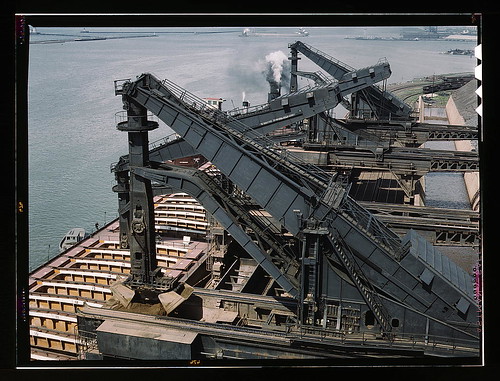
Perhaps you remember the Hulett Ore Unloaders, the massive machines designed by Clevelander George Hulett that revolutionized the process of removing ore from freighters? They sat, rusting away, on Whiskey Island until 2000, when they were demolished. The four here in Cleveland were the first four built, and the last four remaining.

This set of fifteen 4x5 transparencies was created by Jack Delano in May of 1943. It is part of the Farm Security Administration - Office of War Information Collection in the American Memory Project at the Library of Congress. There, you can download massive 140 meg tiffs of these transparencies. There does not seem to be a way to link to them as a set, but they can be linked to individually. 1 2 3 4 5 6 7 8 9 10 11 12 13 14 15
Above, we see the scoop of the Hulett open as it descends down into the freighter.

The arm of the unloader has descended all the way into the ship to scoop out the iron ore.

With the scoop full, it lifts up out of the freighter.

The iron ore is then deposited and weighed.

Finally, the ore is dropped into hopper cars waiting below, to go off to the steel mills.
We all should have done more to prevent the demolition of these rust belt icons. A major landmark was lost when the Huletts were dismantled. Our past is that of industry and manufacturing. We ought to embrace it.




Never understood why they were discarded so quickly. Not a whole lot of care and thought went into yet another loss of part of our rich heritage.
ReplyDeleteClevlanders played a major role in building this nation – that ore left here destined for skyscrapers, automobiles, railroads, shopping malls, subways, bridges, et. al., all over this nation.
But the derisive nature of the "Rustbelt" tag marginalized our and other cities' contributions not only in the minds of the sunbelt folks but also those who were making decisions here, too.
Innovation, progress and the march of technology are our future, but you can't simply s***can the things that got us this far because they're obsolete.
Dumb.
You can switch over to a gallery view to see thumbnails.
ReplyDeleteMore Hulett notes: -
ReplyDeleteTwo were disassembled with the thought of reassembly-their traveling bases remain upright on Whiskey Island while the rest of the components are rotting away on the ground.
-There are two Huletts still working along the Calumet River near South Chicago-they can be seen on Google Earth.
-The Lakefront Huletts were one of several sets in Cleveland. There were Huletts along the old river bed near Division Avenue, US Steel had Huletts at Central Furnace and Republic Steel (later LTV) at two sets upriver.
-The self-unloading lakeboat killed the Hulett. A self-unloader can discharge cargo in far less time than a "straightdecker" using Huletts.
-As much as I love the Huletts and wish they were still around, I can understand the cold hard economics of preserving them. Someone or some organization would have to come up with millions of dollars to rebuild and relocate them. And think of the maintenance costs on giant, century-old machines. It is indeed difficult to get such funding when so many other worthy causes need capital as well.
-The Huletts were discarded quickly because in the eyes of Oglebay Norton and the Port Authority, they were obsolete pieces of equipment standing in the way of expanded operations at the Cleveland Bulk Terminal (CBT). Go to http://www.citizensvision.org/savehuletts/index.htm for some interesting information about efforts to save the Huletts.
The two Huletts in Chicago were scrapped sometime in 2010. See: http://todengine.websitetoolbox.com/post?id=4711901
DeleteCleveland's 2 in storage are the only hope of seeing a Hulett upright again.
I've often thought that had the self-unloader been thought of first—and I don't see why that would not have been possible—the Huletts would have never come into existence. As it is that's not how it happened and I sometimes think of them as Rube Goldberg's triumph, and have fond memories of watching them at work from my window seat at the federal building back in the late 70s/early 80s. They really did look like giant slow-motion grasshopper legs. They were, to use an overused term quite appropriately, awesome.
DeleteI worked for Conrail (Cleveland, Ohio). Back in the 70s, for a short time, I was stationed on Whiskey Island. My job was to walk the tracks and get numbers off those hopper loading cars situated under the Huletts.
ReplyDeleteJoe Kasunic was my boss. I was on the job at 6AM. While walking the tracks I’d look up and see guys operating the Huletts. They’d be going back & forth with shovels grabbing ore off those huge ships parked alongside the shore.
At the time it was only a job. Now, considering their history, I’m glad I was able to get a close up look of those four big monster machines situated on the shores of Lake Erie.
God Bless
Sonino John Paul Scardelletti - A Christian
SONINOSCARDELLETTI@ATT.NET
I've been reading your blog for some time, and only now found this post. If you or your readers are interested, there are currently two videos on Youtube showing the Huletts in operation. The first is Cleveland, the second, Coneaut.
ReplyDeletehttps://www.youtube.com/watch?v=1RJfnk2S330
and
https://www.youtube.com/watch?v=JErREoMOdDc